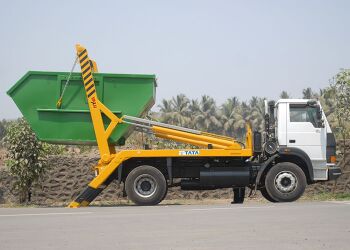Skip Lorry: Difference between revisions
add page specific text |
|||
| (2 intermediate revisions by the same user not shown) | |||
| Line 14: | Line 14: | ||
During tipping the sheeting system is rolled back (if used), and the retaining hooks at the rear of the skip are left locked in place and the legs are extended to provide stability. The lifting arm then pushes the skip upwards at the front to facilitate the material in the skip sliding out as it pivots on the retaining hooks and bar. | During tipping the sheeting system is rolled back (if used), and the retaining hooks at the rear of the skip are left locked in place and the legs are extended to provide stability. The lifting arm then pushes the skip upwards at the front to facilitate the material in the skip sliding out as it pivots on the retaining hooks and bar. | ||
[[File:Skip-loader-gallery01.jpg| | {| class="wikitable" | ||
|- | |||
| [[File:Skip-loader-gallery01.jpg|350px|left|Skip Lorry with skip in process of being loaded on the lorry, all rights reserved Tata Motors]] ||{{#ev:youtube|v=ymcks9L_myE|450|inline| | |start=7&end=76}} | |||
|- | |||
|'''Skip Lorry Loading by Tata Motors'''||'''Video Footage of Skip Lorry loading and unloading by EFR Wakefield Skips''' | |||
|} | |||
Latest revision as of 14:54, 2 August 2022
A Skip Lorry is a type of lorry used to transport a specialised Skip to and from a waste producers' premises. The process is to remove a full skip from a site when the waste producer has finished with it, and if a the same empty Skip is required to be provided back to the site the process is often referred to as 'tip and return'. If a different Skip is used to replace the full skip the process is often referred to as an 'exchange'.

Summary
A Skip Lorry is a type of lorry used to transport a specialised Skip to and from a waste producers' premises. The process is to remove a full skip from a site when the waste producer has finished with it, and if a the same empty Skip is required to be provided back to the site the process is often referred to as 'tip and return'. If a different Skip is used to replace the full skip the process is often referred to as an 'exchange'.
Process
A skip has four 'lugs', one on each corner, which are used for lifting the skip onto the lorry. The lorry has extending arms on either side with two chains on each arm, and the arms extend out over the rear of the lorry and over the top of the skip and the chains are fixed manually to the 'lugs' on each of the four corners of the skip. The lorry also has a set of hydraulic 'legs' that extend from the rear of the lorry and set on the ground to provide extra stabilisation during lifting. Once fixed, the arms are reversed in their motion to firstly draw the skip up and then over onto the back of the lorry before the hydraulic arms are then moved down into a position for transport. The skip is locked into place at the rear of the skip lorry via a set of automatic hooks that locate onto a bar at the rear of the skip.
If the lorry is moving a skip with no lid or top (an open bin/skip) with a risk of the material blowing away during transit, there is a separate automatic 'sheeting system' operated via a separately driven arm that unrolls a sheet of fabric over the container from front to back.
During tipping the sheeting system is rolled back (if used), and the retaining hooks at the rear of the skip are left locked in place and the legs are extended to provide stability. The lifting arm then pushes the skip upwards at the front to facilitate the material in the skip sliding out as it pivots on the retaining hooks and bar.

